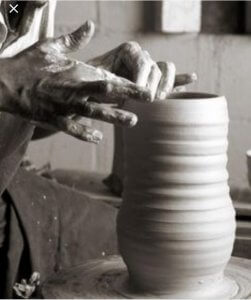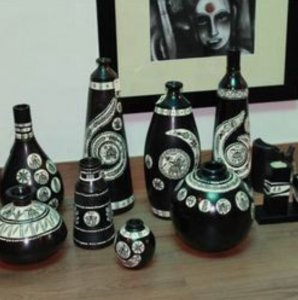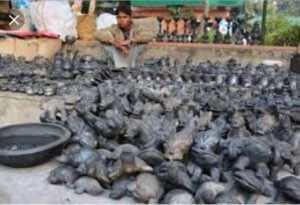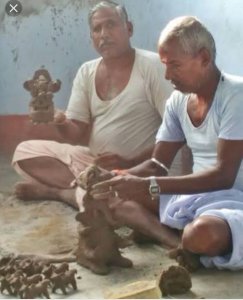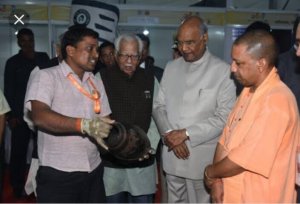India a country with enormous art and literature is a land rich in various culture, designs, ethnicity, scriptures, architect and many more. Among them, the art of pottery is a talent treasure which the country hold. Whenever we listen the word “POTTERY” what comes first in our mind? Majorly a technique of changing wet soil into beautiful shapes via art of hand and wheel. But moreover, it is not limited to this much. Pottery withholds many more facts which will make you curious to know every aspect of it. Let’s take you to a small town of Nizamabad which is 25 km far from Azamgarh district in Uttar Pradesh where pottery is not only a passion but a pride for the people.
Nizamabad had been famous for this art since Mughal rule (Aurangzeb). History says that in mid 17th century Muslim invaders had attacked the town Hanumantgarh (Hindu) which was turned to Nizamabad after conquering it. In the 19th century, one of the feudal rulers called potters from Kutch, Gujarat to live in Nizamabad. In exchange for land, they were asked to make pots, vases, plates. Gradually they were influenced by Muslim form. Slowly and steady the black beauty started attracting people.
Prajapati’s are the people who are well known for this art in town. According to Hindu mythology, it is believed that Lord Brahma had blessed this community for the art of pottery. Nizamabad includes 11 craftsmen who are state awarded and many of them with a national award for their artistic work. Also, this art had got a GI (Graphical Indication) registration which indicates the quality of the product, specialty and Graphical region.
The process of black pottery-
Fine textured clay is used which is locally available. The clay mould is changed into different shapes and is backed in the kiln (furnace). After that, these clay wares are washed with powdered vegetable matter and rubbed with mustard oil. To give it a catchy look they are decorated with floral and geometric patterns with sharp twigs and are kept within rice husks in enclosed kilns which give a unique shiny black surface to it. Oiling and backing procedure is repeated again. The grooves on clay wares are then filled with silvery powder of zinc and mercury washed with water and polished. Lead and Amalgam is also used.
The silver wire around some pieces is inspired by Bidriware (metal handicraft from Bidar). It’s a long process to be done cautiously. Now the black shiny pots and vessels are ready to attract and seduce your eyes. Variety of household and decorative items are made including vases, plates, pots, saucers, lamp, tea-pots, bowls, chillum (pipes), incense stick holder, surahi are the attractions. Also, they make a statue which reflects the divine beauty. People who visit here can’t deny buying these.
The land of Nizamabad holding various mosque resembles the Mughal power of that time and also signify the Muslim dominance in the area. The rooftop and corridors of houses covered with pots drying in sun showcase the feature of the town itself. This is not only an art for people but the source of income and livelihood over there. Men and women both are involved in this.
Major issues :
1. Technology – lack of equipment and electricity.
2. Poor market management
3. Improper export/import.
4. Lack of entrepreneurship.
5. Finance problem.
6. Business development
7. Infrastructure
Many potters are dependent on it for earning but the shiny black pottery had a black phase also. Instead of such a hard work and availability of antique skill potters still, earn Rs- 200- 250/ only for a day which is very less to compete with daily necessities of life. Many of them had turned themselves to a path of agriculture due to poor technique and lack of resources. This had led to an art in danger. In metro cities, Delhi and Mumbai people have an extreme demand for these clay items for decoration but the issues are an obstacle towards it.
Currently, potters are using old technique roof terrace for drying which takes a long time. The major present problem is lack of availability of clay. Potters of Nizamabad are demanding soil bank and proper soil management system for several years but government concern is far from them. Though Samajwadi Party is the ruling constituency of the region from several years. Voices were raised during Akhilesh Yadav government in U.P but the result was nil. All this had changed the mindset of people. Now many of them are shifting to other businesses and are not interested in voting or in a support of any political party.
Reforms to be taken –
1 The government should encourage this art by advertisement
2. Special marketing websites should be assigned for foreign export.
3. Proper electricity and soil management system should be provided.
4. To promote and encourage the art, banks (government and private) should provide loans to potters at low interest.
5. Small corporate industries should be opened.
Recently, present president Ramnath Kovind together with Chief Minister U.P Adityanath Yogi had overlooked the artwork and praised the beauty of it which had raised faith in locals. This art is a gift from our ancestors. It is needed to protect and sustain it for future generations.
Remember pottery is not only an art but a mixture of Passion, Love, Dedication, Hard work of Indian Kumhars (Potters).



